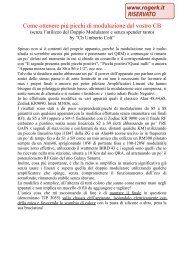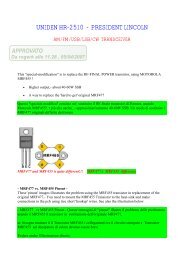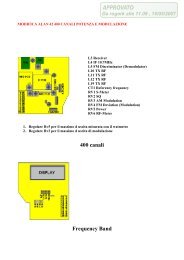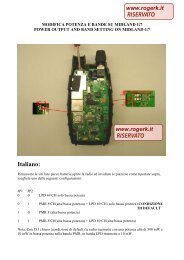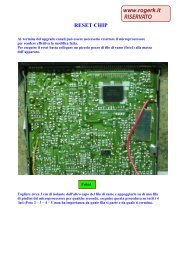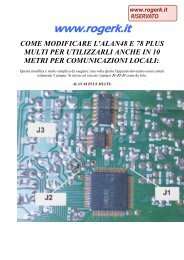Modifications for the ICOM - RogerK
Modifications for the ICOM - RogerK
Modifications for the ICOM - RogerK
- No tags were found...
Create successful ePaper yourself
Turn your PDF publications into a flip-book with our unique Google optimized e-Paper software.
19-07-1998(IC-24) Tip to to function bottom <strong>for</strong> IC-24The Icom IC-24AT (and IC-2SAT) Second Keyboard Functions are activated by pressing AND HOLDING <strong>the</strong> "FUNCTION" buttomon <strong>the</strong> side of <strong>the</strong> transceiver WHILE pressing <strong>the</strong> keypad with <strong>the</strong> desired 2nd function. The disadvantage of this procedure isthat it requires 2 hands to activate a 2nd key function, 1 to press AND HOLD <strong>the</strong> FUNCTION button and 1 to press <strong>the</strong> keypadwith <strong>the</strong> desired 2nd key function.The Solution:I modified <strong>the</strong> operation of <strong>the</strong> FUNCTION button so that it only has to be pressed MOMENTERLY to activate <strong>the</strong> function mode, itremains in <strong>the</strong> function mode <strong>for</strong> approximately 4 seconds <strong>the</strong>reafter. Any second key functions may be selected any time during<strong>the</strong> 4 second interval <strong>the</strong> function mode remains active. The beauty of this feature is that now you can squeeze <strong>the</strong> FUNCTIONbutton with your thumb and <strong>the</strong>n have up to 4 seconds to select <strong>the</strong> desired 2nd key function with <strong>the</strong> index finger of <strong>the</strong> samehand!The Mod:Implementing this modification requires one 4.7uF 10 volt chip capacitor and one 1K Ohm chip resistor. The negative terminal of<strong>the</strong> chip capacitor is soldered to ground. The 1K Ohm resistor is soldered directly to <strong>the</strong> positive terminal of <strong>the</strong> chip capacitor.The o<strong>the</strong>r terminal of <strong>the</strong> chip resistor is soldered to <strong>the</strong> FUNCTION key PC board contact via a small length of fine wire. THATSIT! It works great! I had mine in operation <strong>for</strong> over 1 year. I could NEVER go back to <strong>the</strong> original procedure!This modification is read 814 times.top of page19-07-1998(IC-240) 12,5 Khz mods <strong>for</strong> IC-240Here are mods <strong>for</strong> putting 12,5 kHz step frequency <strong>for</strong> this rig. The basic step frequency is normally 25 kHz, and <strong>the</strong> rig uses adiode matrix board as a "memory" <strong>for</strong> 22 channels.The modifications are useful if you have put frequencies <strong>for</strong> repeater in your chart. After upgrade, you can access to 12,5 kHzbandplan, and <strong>the</strong> total of channels will be 2x22 = 44.The modifications are based on 3 features, that is to say:●●●PLL mods <strong>for</strong> 12,5 kHz stepdeviation adjustment <strong>for</strong> narrow FM (+/- 2,5 kHz)improving selectivity in IF amplifiers (455 kHz), receiving part1) PLL mods <strong>for</strong> 12,5 kHz stepAll mods are done on PLL board located on <strong>the</strong> bottom of <strong>the</strong> rig. The first thing to check is <strong>the</strong> frequency of X-tal X1. It must be6,4 MHz. You can measure <strong>the</strong> value of frequency at pin 11 (25 kHz) and pin 12 (12,5 kHz) of IC6 (uPD4013). This part of IC isused as divider by 2, so <strong>the</strong> reference frequency <strong>for</strong> <strong>the</strong> phase comparator IC1 (TC5081P) is 12,5 kHz. How lucky we are! Youcan adjust perfectly <strong>the</strong> value of <strong>the</strong> reference frequency with C2 trimmer capacitor.The main modification is done by changing <strong>the</strong> loop divider ratio (half part of IC6 and IC1). Depending of <strong>the</strong> programming, <strong>the</strong>total ratio of dividing is between 128 and 288 but always with even ratio_(128, 130, 132...286, 288).The explanation is given by <strong>the</strong> fact that <strong>the</strong> second part of IC6 (uPD4013) used as divider by 2 is in front of programmabledivider IC1 (TC5080P) which gives 64 to 128 dividing ratio. In order to access 12,5 kHz step, <strong>the</strong> total dividing ratio must covervalues such as 129, 131, 133...285, 287).Consequently, we have to replace half part of IC6 (uPD4013) and IC1 (TC5080P) by a new and single programmable divider. Fordoing this job, <strong>the</strong> MC145151 has been choosen. With this IC, we just use <strong>the</strong> programmable divider part. Practical job is doneby using a small piggy board supporting <strong>the</strong> MC145151. An IC socket is soldered instead of IC1 (TC5080P), and <strong>the</strong> small boardis plug on it. This board can be something like bicc veroboard. Do not worry about frequency problems, because <strong>the</strong> highestvalue encountered is about 3,6 MHz.If <strong>the</strong>re is a 10 kohms resistor between pin 1 of IC6 (uPD4013) and pin 15 of IC1 (TC5080P), you have to desolder it. On this pin15, you have to solder a capacitor of 220 pF to pin 3 of IC6 (uPD4013). Mount this capacitor on <strong>the</strong> copper side of <strong>the</strong> PC board.Now <strong>the</strong> piggy board has to be wired following this chart:MC145151 pins IC1 socket pins remarks(1) (15) f in(2) (9) ground




